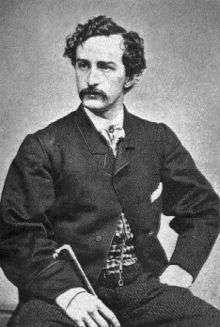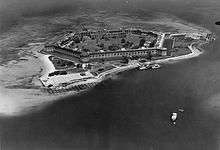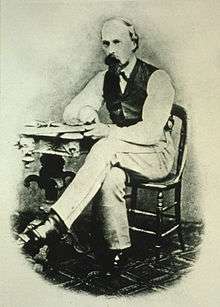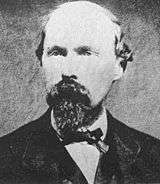Samuel Mudd
| Samuel Alexander Mudd | |
|---|---|
|
Samuel Alexander Mudd, M.D. | |
| Born |
December 20, 1833 Charles County, Maryland, U.S. |
| Died |
January 10, 1883 (aged 49) Waldorf, Maryland, U.S. |
| Occupation | Medical Doctor |
| Known for | being John Wilkes Booth's doctor |
| Spouse(s) | Sarah Frances Dyer Mudd |
| Children |
Andrew Jerome Mudd Lillian Augusta Mudd Thomas Dyer Mudd Samuel Alexander Mudd, II Henry Mudd Stella Marie Mudd Edward Joseph Mudd Rose De Lima Mudd Mary Eleanor Mudd |
| Parent(s) |
Henry Lowe Mudd Sarah Ann Reeves |
Samuel Alexander Mudd (December 20, 1833 – January 10, 1883) was an American physician who was imprisoned for conspiring with John Wilkes Booth in the assassination of U.S. President Abraham Lincoln.
While working as a doctor in Southern Maryland, Mudd also employed slaves on his tobacco farm, and declared his belief in slavery as a God-given institution. The Civil War seriously damaged his business, especially when Maryland abolished slavery in 1864. At this time, he first met Booth, who was planning to kidnap Lincoln, and Mudd was seen in company with three of the conspirators. But his part in the plot, if any, remains unclear.
After mortally wounding Lincoln on April 14, 1865, Booth rode with conspirator David Herold to Mudd’s home in the early hours of the 15th for surgery on his fractured leg, before crossing into Virginia. Some time that day, Mudd must have learned of the assassination, but did not report Booth’s visit to the authorities for another 24 hours. This appeared to link him to the crime, as did his various changes of story under interrogation, and on April 26, he was arrested. A military commission found him guilty of aiding and conspiring in a murder, and he was sentenced to life imprisonment, escaping the death penalty by a single vote.
Mudd was pardoned by President Andrew Johnson and released from prison in 1869. Despite repeated attempts by family members and others to have it expunged, his conviction has never been overturned.
Early years
Born in Charles County, Maryland, Mudd was the fourth of 10 children of Henry Lowe and Sarah Ann Reeves Mudd. He grew up on Oak Hill, his father's tobacco plantation of several hundred acres, which was located 30 miles (48 km) southeast of downtown Washington, D.C., and which was worked by 89 slaves.[1][2]
At the age of 15, after several years of home tutoring, Mudd went off to boarding school at St. John's Literary Institute now known as Saint John's Catholic Prep School in Frederick, Maryland. Two years later, he enrolled at Georgetown College in Washington, D.C.. He then studied medicine at the University of Maryland, Baltimore, writing his thesis on dysentery.
Upon graduation in 1856, Mudd returned to Charles County to practice medicine, marrying his childhood sweetheart, Sarah Frances (Frankie) Dyer Mudd one year later.[3] As a wedding present, Mudd's father gave the couple 218 acres (0.88 km2) of his best farmland and a new house named St. Catherine. While the house was under construction, the young Mudds lived with Frankie's bachelor brother, Jeremiah Dyer, finally moving into their new home in 1859. They had nine children in all; four before Mudd's arrest and five after his release from prison.[4] To supplement his income from his medical practice, Mudd became a small scale tobacco grower, using five slaves according to the 1860 U.S. Slave Census.[5] Mudd believed that slavery was divinely ordained, writing a letter to the theologian Orestes Brownson to that effect.[6]
With the advent of the American Civil War in 1861, the Southern Maryland slave system and the economy it supported rapidly began to collapse. In 1863, the Union Army established Camp Stanton just 10 miles (16 km) from the Mudd farm to enlist black freedmen and run-away slaves. Six regiments totaling over 8,700 black soldiers, many from Southern Maryland, were trained there. In 1864, Maryland, which was exempt from Lincoln's 1863 Emancipation Proclamation, abolished slavery, making it difficult for growers like Mudd to operate their plantations. As a result, Mudd considered selling his farm and depending on his medical practice. As Mudd pondered his alternatives, he was introduced to someone who said he might be interested in buying his property, the 26-year-old actor John Wilkes Booth.
Booth connection
Many historians agree that President Abraham Lincoln's future assassin, John Wilkes Booth, visited Bryantown, Maryland, in November and December 1864, claiming to look for real estate investments. Bryantown is about 25 miles (40 km) from Washington, D.C., and about 5 miles (8.0 km) from Mudd's farm. The real estate story was merely a cover; Booth's true purpose was to plan an escape route as part of a plan to kidnap Lincoln. Booth believed the federal government would ransom Lincoln by releasing a large number of Confederate prisoners of war.

Historians agree that Booth met Mudd at St. Mary's Catholic Church in Bryantown during one of those visits, probably in November. Booth visited Mudd at his farm the next day, and stayed there overnight. The following day, Booth purchased a horse from Mudd's neighbor and returned to Washington. Some historians[7] believe that Booth used his visit to Bryantown to recruit Mudd to his kidnapping plot, although others believe that Mudd would have had no interest in such a scheme.
A short time later, on December 23, 1864, Mudd went to Washington where he met Booth again. Some historians believe the meeting had been arranged, but others disagree. The two men, as well as John Surratt, Jr. and Louis J. Weichmann, had a conversation and drinks together, first at Booth's hotel, and later at Mudd's.
According to a statement made by associated conspirator George Atzerodt, found long after his death and taken down while he was in federal custody on May 1, 1865, Mudd knew in advance about Booth's plans; Atzerodt was sure the doctor knew, he said, because Booth had "sent (as he told me) liquors & provisions [...] about two weeks before the murder to Dr. Mudd's".[8]
Although this is a true statement, some historians believe that there may be other reasons behind Mudd’s relationship to Booth. The trial brought forth many theories of Mudd’s involvement within the assassination of President Lincoln. One theory posits that Dr. Mudd was involved in a completely different conspiracy to gain an upper hand for the southern states. Prior to the assassination of President Lincoln, Booth originally intended to kidnap the president and hold him and other political affiliates of the Union for a large sum of money.[9] This plan was in effect until the night of the assassination, when John Wilkes Booth met up with Atzerodt, David Herold and Lewis Paine and disclosed the plot to assassinate the president.[9] Following the assassination, Lewis Pane came forth by stating that Booth had only told him prior to the meeting and the other men did not know about the plot until the night of the assassination.[9] This supports the theory that Dr. Mudd may have been an accomplice to the plot to kidnap the president, but not a conspirator to the assassination of Abraham Lincoln.
After Booth shot President Lincoln on April 14, 1865, he broke his left fibula while fleeing Ford's Theater. Booth met up with Herold and together they made for Virginia via southern Maryland. They stopped at Mudd's house around four o'clock in the morning on April 15. Mudd splinted Booth's leg. He also arranged for a carpenter, John Best, to make a pair of crutches for Booth, and gave him a shoe to wear.[8] Booth paid Mudd twenty-five dollars in greenbacks for his services. He and Herold spent between twelve and fifteen hours at Mudd's house. They slept in the front bedroom on the second floor. It is unclear whether Mudd had been informed that Booth had murdered President Lincoln at that point.
Mudd went to Bryantown during the day on April 15 to run errands; if he did not already know the news of the assassination from Booth, he certainly learned of it on this trip. He returned home that evening, and accounts differ as to whether Booth and Herold had already left, whether Mudd met them as they were leaving, or whether they left at Mudd's urging and with his assistance.
Whichever is true, Mudd did not immediately contact the authorities. When questioned, he stated that he had not wanted to leave his family alone in the house lest the assassins return and find him absent and his family unprotected. He waited until Mass the following day, Easter Sunday, when he asked his second cousin, Dr. George Mudd — a resident of Bryantown — to notify the 13th New York Cavalry in Bryantown under the command of Lieutenant David Dana. This delay in contacting the authorities drew suspicion and was a significant factor in tying Mudd to the conspiracy.
During his initial investigative interview on April 18, Mudd stated that he had never seen either of the parties before.[10][11] In his sworn statement of April 22, he told about Booth's visit to Bryantown in November 1864, but then said "I have never seen Booth since that time to my knowledge until last Saturday morning."[12] He deliberately hid the fact of his meeting with Booth in Washington in December 1864. In prison, Mudd belatedly admitted the Washington meeting, saying he ran into Booth by chance during a Christmas shopping trip. Mudd's failure to mention the meeting in his interview with detectives was a big mistake. When Weichmann later told the authorities of this meeting, they realized Mudd had misled them, and immediately began to treat him as a suspect rather than a witness.
During the conspiracy trial, Lieutenant Alexander Lovett testified that "On Friday, the 21st of April, I went to Mudd's again, for the purpose of arresting him. When he found we were going to search the house, he said something to his wife, and she went up stairs and brought down a boot. Mudd said he had cut it off the man's leg. I turned down the top of the boot, and saw the name 'J. Wilkes' written in it."[13]
Trial

After Booth's death (April 26, 1865), Mudd was arrested and charged with conspiracy to murder Abraham Lincoln. Congressman Frederick Stone was the senior defense counsel for Mudd.[14]
On May 1, 1865, President Andrew Johnson ordered the formation of a nine-man military commission to try the conspirators. Mudd was represented by General Thomas Ewing, Jr.. The trial began on May 10, 1865. Mary Surratt, Lewis Powell, George Atzerodt, David Herold, Samuel Mudd, Michael O'Laughlen, Edmund Spangler and Samuel Arnold were all charged with conspiring to murder Lincoln.[15] The prosecution called 366 witnesses.[16]
The defense sought to prove that Mudd was a loyal citizen, citing his self-description as a "Union man" and asserting that he was "a deeply religious man, devoted to family, and a kind master to his slaves".[16] The prosecution presented witnesses who testified that he had shot one of his slaves in the leg, and threatened to send others to Richmond, Virginia to assist in the construction of Confederate defenses. The prosecution also contended that he had been a member of a Confederate communications distribution agency and had sheltered Confederate soldiers on his plantation.[16]
On June 29, 1865, Mudd was found guilty with the others. The testimony of Louis J. Weichmann was crucial in obtaining the convictions. According to the historian Edward Steers, the testimony presented by former slaves was also crucial, although it faded from public memory.[16] Mudd escaped the death penalty by one vote and was sentenced to life imprisonment. Four of the defendants, Surratt, Powell, Atzerodt and Herold, were hanged at the Old Penitentiary at the Washington Arsenal on July 7, 1865.
Imprisonment
Mudd, O'Laughlen, Arnold and Spangler were imprisoned at Fort Jefferson in the Dry Tortugas about 70 miles (110 km) west of Key West, Florida. The fort housed Union Army deserters and held about six hundred prisoners when Mudd and the others arrived. Prisoners lived on the second tier of the fort, in unfinished open-air gun rooms called casemates. Mudd and his three companions lived in the casemate directly above the fort's main entrance, called the sally port.

In September, 1865, two months after Mudd arrived, control of Fort Jefferson was transferred from the 161st New York Volunteers to the 82nd United States Colored Infantry. On September 25, 1865, he attempted to escape from Fort Jefferson by stowing away on the transport Thomas A. Scott. Some historians believe that as a recent slave owner and a person convicted of conspiring to kill the president whose presidency led to the freeing of the slaves, Mudd was fearful of his treatment by the incoming 82nd United States Colored Infantry and this is why he made his bid for freedom.
He was quickly discovered and placed in the fort's guardhouse. On October 18, he was transferred along with Samuel Arnold, Michael O'Laughlen, Edmund Spangler, and George St. Leger Grenfell to a large empty ground-level gunroom the soldiers referred to as "the dungeon". Mudd and the others were let out of the dungeon six days a week to work around the fort. On Sundays and holidays they were confined inside. The men wore leg irons while working outside, but the irons were removed when inside the dungeon.
After three months in the dungeon, Mudd and the others were returned to the general prison population. However, because of his attempted escape, Mudd lost his privilege of working in the prison hospital and was assigned to work in the prison carpentry shop with Spangler.
There was an outbreak of yellow fever in the fall of 1867 at the fort. Michael O'Laughlen eventually died of it on September 23. The prison doctor died and Mudd agreed to take over the position. In this role he was able to help stem the spread of the disease. The soldiers in the fort wrote a petition to President Johnson in October 1867 stating the degree of Mudd's assistance, "He inspired the hopeless with courage and by his constant presence in the midst of danger and infection.... [Many] doubtless owe their lives to the care and treatment they received at his hands."[17] Probably as a reward for his work in the yellow fever epidemic, Dr. Mudd was reassigned from the carpentry shop to a clerical job in the Provost Marshall's office, where he remained until his pardon.
Career after release
Due in part to the influence of his defense attorney, Thomas Ewing Jr., who was influential in the President's administration, on February 8, 1869, Mudd was pardoned by President Andrew Johnson. He was released from prison on March 8, 1869 and returned home to Maryland on March 20, 1869. On April 1, 1869, three weeks after he pardoned Mudd, Johnson also pardoned Spangler and Arnold.
When Mudd returned home, well-wishing friends and strangers, as well as inquiring newspaper reporters, besieged him. Mudd was very reluctant to talk to the press because he felt they had misquoted him in the past. He gave one interview after his release to the New York Herald, but immediately regretted it, complaining that the article had several factual errors and that it misrepresented his work during the yellow fever epidemic. On the whole though, Mudd continued to enjoy the friendship of his friends and neighbors. He resumed his medical practice and slowly brought the family farm back to productivity.
In 1873, Spangler traveled to the Mudd farm, where Mudd and his wife welcomed him as the friend whom Mudd credited with saving his life while suffering with yellow fever at Fort Jefferson. Spangler lived with the Mudd family for about eighteen months, earning his keep by doing carpentry, gardening, and other farm chores, until his death on February 7, 1875.
Mudd always had an interest in politics. While in prison, he stayed abreast of political happenings through the newspapers he was sent. After his release, he became active again in community affairs. In 1874, he was elected chief officer of the local farmers association, the Bryantown Grange. In 1876, he was elected Vice President of the local Democratic Tilden-Hendricks presidential election committee. Tilden lost that year to Republican Rutherford B. Hayes in a hotly disputed election. The next year Mudd ran as a Democratic candidate for the Maryland House of Delegates, but was defeated by the popular Republican William Mitchell.
Mudd's ninth child, Mary Eleanor "Nettie" Mudd, was born in 1878. That same year, he and his wife temporarily took in a seven-year-old orphan named John Burke, one of 300 abandoned children sent to Maryland families from the New York City Foundling Asylum run by the Catholic Sisters of Charity. The Burke boy was permanently settled with farmer Ben Jenkins.
In 1880, the Port Tobacco Times reported that Mudd's barn containing almost eight thousand pounds of tobacco, two horses, a wagon, and farm implements was destroyed by fire.
Mudd was just 49 years old when he died of pneumonia on January 10, 1883. He is buried in the cemetery at St. Mary's Catholic Church in Bryantown, the same church where he once met with John Wilkes Booth.
Posthumous rehabilitation attempts

Mudd's grandson, Dr. Richard Mudd, tried unsuccessfully to clear his grandfather's name from the stigma of aiding John Wilkes Booth. In 1951, he published The Mudd Family of the United States, an encyclopedic two-volume history of the Mudd family in America, beginning with Thomas Mudd who arrived from England in 1665. A second edition was published in 1969. Following his death in 2002, Dr. Mudd’s papers,[18] which detail his attempts to clear his grandfather’s name, were donated to Georgetown University’s Lauinger Library, where they are available to the public in the Special Collections Department.[19]
Richard Mudd petitioned several successive presidents, receiving replies from presidents Jimmy Carter and Ronald Reagan. Carter, while sympathetic, responded that he had no authority under law to set aside the conviction; Reagan, that he had come to believe that Samuel Mudd was innocent of any wrongdoing. In 1992 Representatives Steny Hoyer and Thomas W. Ewing introduced House Bill 1885 to overturn the conviction, but it failed while in committee. Mudd then turned to the Army Board for Correction of Military Records, which recommended that the conviction be overturned on the basis that Mudd should have been tried by a civilian court. The recommendation was rejected by Acting Assistant Secretary of the Army William D. Clark.
Several other legal venues were attempted, ending in 2003 when the U.S. Supreme Court refused the case, stating that the deadline for filing had been missed.[20]
St. Catharine, also known as the Dr. Samuel A. Mudd House, was listed on the National Register of Historic Places in 1974.[21]
Film, radio, and television
Mudd's life was the subject of a 1936 John Ford-directed film The Prisoner of Shark Island, based on a script by Nunnally Johnson. A radio adaptation of The Prisoner of Shark Island aired as an episode of the radio series Lux Radio Theater, with Gary Cooper as Dr. Mudd, on May 2, 1938, in which significant dramatic license was used (introducing fictional characters, and altering several of the known facts of the case, for melodramatic expediency). Another production with the same title aired on the radio series Encore Theatre, in 1946. Another film, entitled The Ordeal of Dr. Mudd, was made in 1980. It starred Dennis Weaver as Mudd. All of these productions espoused the point of view that Mudd was essentially innocent of any conspiracy.
Roger Mudd, an Emmy Award-winning journalist, television host and former CBS, NBC and PBS news anchor is related to Samuel Mudd, though he is not a direct descendant, as has been mistakenly reported.[22]
Samuel Mudd's life was also the subject of an episode in 1962 of the TV western Laramie entitled "Time of the Traitor".
On the episode "Swiss Diplomacy" of the NBC Drama The West Wing, first lady (and cardiac surgeon) Dr. Abby Bartlet commented on the duty of a physician to treat an injured patient despite potential legal repercussions. She responded to Mudd's conviction with "So that's the way it goes. You set the leg."[23]
Samuel Mudd is sometimes given as the origin of the phrase "your name is mud", as in, for example, the 2007 film National Treasure: Book of Secrets. However, according to an online etymology dictionary, this phrase has its earliest known recorded instance in 1823, ten years before Mudd's birth, and is based on an obsolete sense of the word "mud" meaning "a stupid twaddling fellow".[24][25]
References
- ↑ Mudd, Dr. Richard D. (1951). The Mudd Family of the United States. Volume 1 (Second ed.). Saginaw, Michigan: Dr. Richard D. Mudd. pp. 520 ff.
- ↑ Steers, Edward; Holzer, Harold (2007). Lincoln Legends. University Press of Kentucky. ISBN 978-0-8131-2466-7.
- ↑ Mudd, Nettie (1906) [1906]. The Life of Dr. Samuel A. Mudd (Fourth ed.). New York and Washington: Neale Publishing Company.
- ↑ Andrew Jerome Mudd (1858–1882), Lillian Augusta "Sissie" Mudd (1860–1940), Thomas Dyer Mudd (1862–1929) and Samuel Alexander Mudd, II (1864–1930),(Henry Mudd (born 1870, died at eight months), Stella Marie Mudd (1871–1952), Edward Joseph Mudd (1873–1946), Rose De Lima "Emie" Mudd (1875–1943), and Mary Eleanor "Nettie" Mudd (1878–1943.
- ↑ "1860 Federal Slave Census, Bryantown, Charles County, Maryland, Slave Owner: Samuel Mudd.".
- ↑ Steers, Edward; Holzer, Harold (2007). Lincoln Legends. University Press of Kentucky. ISBN 978-0-8131-2466-7.
- ↑ http://civilwarstudies.org/articles/Vol_1/mudd.shtm 5th paragraph
- 1 2 "The Text of George Atzerodt's Lost Confession". Rogerjnorton.com. December 29, 1996. Retrieved January 4, 2014.
- 1 2 3 Prior, L. O.. (1964). Lewis Payne, Pawn of John Wilkes Booth. The Florida Historical Quarterly, 43(1), 1–20. Retrieved from http://www.jstor.org/stable/30140073
- ↑ "Dr. Samuel A. Mudd". Historynet.com. Retrieved December 27, 2008.
- ↑ Steers, Edward (2005). Blood on the Moon: The Assassination of Abraham Lincoln. University Press of Kentucky. ISBN 978-0-8131-9151-5.
- ↑ "Investigation and Trial Papers Relating to the Assassination of President Lincoln" (Signed Statement of Dr. Samuel A. Mudd, April 22, 1865 ed.). U.S. National Archives, Washington, D.C., microfilm publication M-599. 1865.
- ↑ Steers, Edward (2003). The trial: the assassination of President Lincoln and the trial of the conspirators. University Press of Kentucky.
- ↑ The Washington Post. "Death of Judge Fred Stone." October 18, 1899: 9.
- ↑ Pitman, Benn (1865) [1865]. The Assassination of President Lincoln and the Trial of the Conspirators. New York: Moore, Wilstach & Baldwin.
- 1 2 3 4 Steers, Edward. "Dr. Mudd and the 'Colored' Witnesses". Kent State University Press. Retrieved June 17, 2009.
- ↑ "Dr. Samuel A. Mudd Pardon, File # B-596". U.S. National Archives, College Park, Maryland.
- ↑ "Mudd, Richard D., Papers". Repository.library.georgetown.edu. June 13, 2013. Retrieved January 4, 2014.
- ↑ "Digital and Special Collections @ Georgetown University". Repository.library.georgetown.edu. Retrieved January 4, 2014.
- ↑ Aitken, Robert (2008). Law Makers, Law Breakers, and Uncommon Trials. American Bar Association. ISBN 978-1-59031-880-5.
- ↑ National Park Service (2008-04-15). "National Register Information System". National Register of Historic Places. National Park Service.
- ↑ Goldstein, Richard (May 25, 2002), "Dr. Richard Mudd, 101, Dies; Grandfather Treated Booth", The New York Times
- ↑ "Swiss Diplomacy". West Wing Transcripts. Retrieved September 1, 2009.
- ↑ "Your name is mud". The Phrase Finder. Retrieved January 13, 2008.
- ↑ "mud". Online Etymology Dictionary. Retrieved January 13, 2008.
http://civilwarstudies.org/articles/Vol_1/mudd.shtm His Name Is Still Mudd, by Edward Steers
External links
| Wikisource has original text related to this article: |
| Wikimedia Commons has media related to Samuel Alexander Mudd I. |
- Dr. Samuel A. Mudd House and Museum
- Dr. Samuel A. Mudd Research Site
- Dr. Mudd and the Lincoln Conspiracy
- Dr. Mudd's attempted escape from Fort Jefferson
- Samuel A. Mudd at Findagrave.com
- The Prisoner of Shark Island - Lux Radio Theater, May 2, 1938
